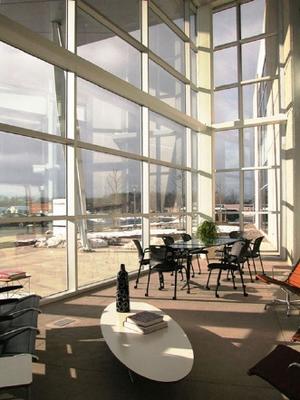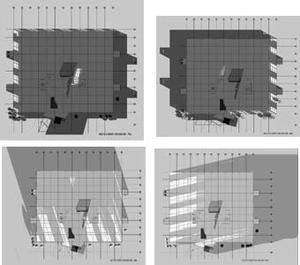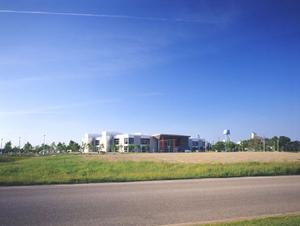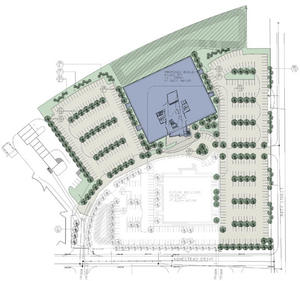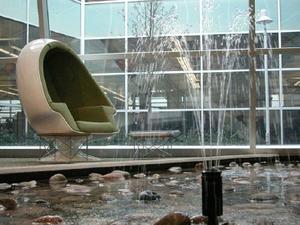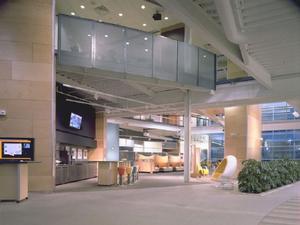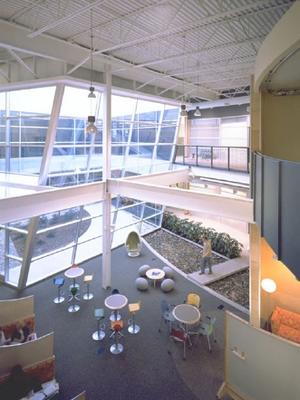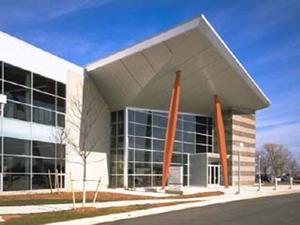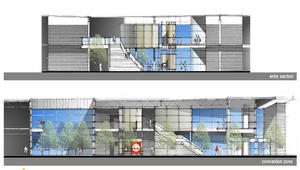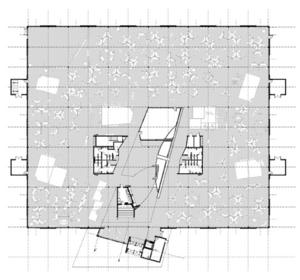Herman Miller MarketPlace
Project Overview
The goal of the Herman Miller MarketPlace was to create a prototype office environment that supports progressive business-place thinking within a sustainable framework. The expectation of this 95,000-square-foot speculative office was nothing less than that it be a great place to work.
Design & Innovation
Predesign
This project, a speculative office building, was designed and developed to achieve a LEED Silver rating. A variety of sustainable strategies, as outlined by the U.S. Green Building Council, were then built into the specifications, drawn into the construction documents, executed through construction, and confirmed through commissioning exercises. The client's commitment to the environment resulted in obtaining a Gold rating.
Design
The developer offered to the client, Herman Miller, a flexible, LEED-influenced building outline that supported the inclusion of tenant-specific goals. The design process involved not only the developer, but also the tenant so that the tenant could incorporate LEED considerations for energy use, lighting, and material use into their build-out. Language in the design documents included requirements that would exceed the LEED Silver rating; varying levels of compliance with LEED standards were designed into the outline specification so that a potential tenant could determine the level of certification.
Construction
LEED was on the agenda at construction meetings and credit-tracking tools were utilized to assure the follow-through of each point.
A construction waste management plan and an indoor air quality plan were utilized during construction.
Operations/Maintenance
The strong relationship among the owner, tenant, and design team made operations and maintenance easy to execute per LEED standards.
Commissioning
Commissioning was conducted throughout the construction phase. The PECI commission guide specification was used as a template to satisfy all LEED requirements.
Regional/Community Design
This building is the first of an environmentally sensitive commercial development that includes plans for a second office structure and a hotel—the first to serve the city of Zeeland. The result will be a commercial development illustrating the positive economies of sustainable design.
Visible from the state roadway, the green space and tree-filled parking lot offer a pleasant alternative to traditional commercial development.
A bicycle rack is located adjacent to the main entry and four showers with lockers are available within the building for cyclists' use. In order to reduce the size of the parking lot, the built capacity is less than the township ordinance for parking capacity. Signage was designed and installed to identify 22 parking stalls specifically designated for vanpooling and carpooling. To promote alternative transportation, these signs were placed at the closest locations to the main entry. Additionally, alternative refueling stations provide receptacles to recharge electric-vehicle batteries.
Land Use & Site Ecology
The development of an environmentally sensitive and economically viable office project began before soil was moved, with the development of a site sediment and erosion control plan that conforms to the EPA standard. Prior to the start of this project, the land was used to store fill materials. It was void of trees and supported only sparse vegetation. Site selection was per LEED requirements and stormwater management was designed to exceed county requirements, resulting in no net increase in the rate or quantity of runoff from the site. The county agency requires that a 25-year storm event be detained and the project was designed to detain a 100-year storm event.
The parking lot's heat-island potential was reduced by orienting parking lot islands on an east-west axis and planting trees to maximize the shading of southern sun. These trees will provide shade for 30% of non-roof impervious surfaces within five years. The minimum number of trees required is 93. 115 were planted.
Bioclimatic Design
Located in a commercial development next to a McDonald's restaurant, MarketPlace demonstrates that green buildings can be woven successfully into the commercial landscape.
The entire design team worked to create an effective building without losing track of the initial cost. The target was an HVAC system that requires 40% lower energy cost than what is budgeted in the baseline model ASHRAE 90.1-1999. Current operating records show this goal is being met.
Light & Air
The client, Herman Miller, "is built on people, values, and a commitment to Great Places to Work," according to the company. It was imperative that this project, although not owned by Herman Miller, reflect their commitment. Providing ample space and daylight, and meeting or exceeding fresh-air standards resulted in an environment that staff describe as "SO Herman Miller."
Water Cycle
Water conservation is achieved by flushless urinals and flow regulators on toilets, lavatories, and showers. Landscape plantings should thrive in Michigan's climate. Plants will be hand-watered only for the first season, until they become established.
Energy Flows & Energy Future
MarketPlace achieves significant energy savings by using standard HVAC products available from multiple manufacturers. The HVAC system's installed cost is less than $14 per square foot and realizes a 40% reduction in energy use over ASHRAE standard 90.1.
A building automation system allows users to control systems including highly efficient rooftop units, variable air volume energy-recovery units, and perimeter radiant heating.
Abundant daylight also decreases the amount of energy needed for indoor lighting, with glass accounting for more than 62% of the building's exterior walls. Carefully selected light sources maintain an average of 0.9 watts per square foot and minimize lighting-system energy demands. The lighting strategy was to provide adequate general light in coordination with passive daylighting. Task lighting at the work surface is used only when required.
Metrics
Materials & Construction
The goal of the project was to achieve the highest possible LEED rating. As a result, the specification book included the following codes and standards.
3.02 Codes and Standards
A. Comply with LEED Materials Credit 4 requirements:
Use materials that contain minimum 20% by weight post-consumer recycled content or 40% by weight post-industrial recycled content.
B. Comply with LEED Materials Credit 7 requirements:
Use a minimum 50% of wood-based materials certified in accordance with the Forest Stewardship Council guidelines for wood building components.
C. Comply with LEED Materials Credit 5 requirements:
Use building materials that have been manufactured within 500 miles for 20% of total materials.
Of those 20%, specify at least 50% that were extracted, harvested, or recovered within 500 miles.
Our commitment to sustainable materials was woven throughout the specification book. Each section featured an "environmental considerations" topic addressing specific, relevant environmental concerns. As an example, the following addresses concrete forms:
Environmental Considerations
A. Problems:
Wood used for formwork contributes to irresponsible forest management practices.
Wood used for formwork ends up in landfills.
B. Recommendations:
-Use non-wood forms made of recycled materials.
-Use wood forms from certified sources.
-Use salvaged wood.
-Re-use form lumber for framing and sheathing.
-Use locally produced materials.
The project earned exemplary performance credit in LEED for both recycled content and regional materials.
Sitework included 100% post-consumer recycled crushed concrete. Concrete rebar was 100% recycled. Structural steel was 90% post-consumer recycled. Metal joists, floor deck, and roof deck were all 95% post-consumer recycled.
Diversion of Construction & Demolition Waste
Just over 50% by weight of the total construction waste was recycled. The remainder was placed in a landfill. Triangle Associates, the project general contractor, implemented a construction waste management plan in which multiple dumpsters were labeled for wood, concrete, scrap metal, cardboard, and general refuse. All subcontractors were expected to comply and dispose of their wastes in the appropriate containers. If they did not comply, they were mandated per contract to re-separate the contents of the appropriate containers and dispose of the materials correctly. If they still did not comply, the work was done by Triangle Associates and back-charged to the subcontractor.
Collective Wisdom & Feedback Loops
The building tenant, Herman Miller, and the building owner, the Granger Group of Companies, continue to perform numerous tests on the building and monitor energy use. The Trane Building Software for measurement and verification continues to be used.
Other Information
The lease agreement that mandated a LEED-rated project directly tied the cost of the base rent into achieving that rating. That motivation helped maintain the green focus. It also helped the project earn an Innovation and Design Process point. The final LEED review states: "This type of agreement fosters the development of the green building market and creates a model for future owners/lessees by expanding green buildings to a wider audience."
Financing Mechanisms
-Procurement process: Performance based contracts, Design-build
Cost Data
Cost data in U.S. dollars as of date of completion.
-Total project cost (land excluded): $8,455,000
This project, built for an economical $89 per square foot, illustrates that a LEED Gold building can be cost effective.
The value metrics of the project show the following savings over a traditional 100,000-square-foot building, with a 7-year lease:
-Building costs, including tenant improvements: 33%
-FF&E costs: 11%
-Operations costs for 5 months of occupancy: 41%
-Churn costs (IFMA baseline: 44% churn at $748 per move): 66%
-The actual amount saved in operational costs over a seven-year lease has been calculated at $1,001,000
Sustainable design must begin as early in the design process as possible, not just added at the end. It is critical to set roles and expectations at the beginning of the project as LEED points can be lost by simple mistakes. As an example, we lost a LEED point because an HVAC filter was installed backwards. While the intent was there, the execution for that particular point was not. Even so, we discovered that the LEED process is flexible, assisting projects in becoming as "green" as possible instead of mandating a singular path to green perfection.
This project achieved its LEED Gold rating because the client is corporately committed to the environment. Mike Volkema, chairman and CEO of Herman Miller, Inc., says, regarding the company's commitment to the environment: "We strive to contribute to a world of ecological balance and economic abundance. We build sustainability into all aspects of our business . . . ." That dedication to sustainable business practices allowed us to move the project to its Gold rating. While we continually educate our clients on the benefits of green design and move projects from traditional to sustainable design, it requires a truly committed client to achieve high LEED ratings.
Most importantly, we discovered that no matter how committed our firm is to green design, sustainability is not something that we can accomplish on our own. Successful sustainable design is the result of a commitment by all members of the team, including the architect, client, and contractor.
Additional Images
Project Team and Contact Information
| Role on Team | First Name | Last Name | Company | Location |
|---|---|---|---|---|
| Architect (Project manager) | Tim | Mustert, AIA | Integrated Architecture | Grand Rapids, MI |
| Architect | David | Huizenga | Integrated Architecture | Grand Rapids, MI |
| Architect (LEED coordinator) | Scott | Vyn | Integrated Architecture | Grand Rapids, MI |
| Architect (Interior designer) | Kristin | Dorias | Integrated Architecture | Grand Rapids, MI |
| Owner/developer | Gary | Granger | The Granger Group of Companies | Grand Rapids, MI |
| Client | Len | Pilon | Herman Miller | Zeeland, MI |
| Contractor | Triangle Associates | Walker, MI | ||
| Civil engineer (Civil consultant) | Driesenga & Associates, Inc. | Holland, MI | ||
| Electrical engineer | Feyen-Zylstra | Grand Rapids, MI | ||
| Structural engineer | JDH Engineering, Inc. | Grandville, MI | ||
| Mechanical engineer | BETA Design Group | Grand Rapids, MI | ||
| Interior designer | Tom | Powers | Interior Architects - Chicago | Chicago, IL |
| Landscape architect | Michael J. Dul & Associates | Pontiac, MI | ||
| Director of communications | Jon | Austin | The Granger Group of Companies | Grand Rapids, MI |










